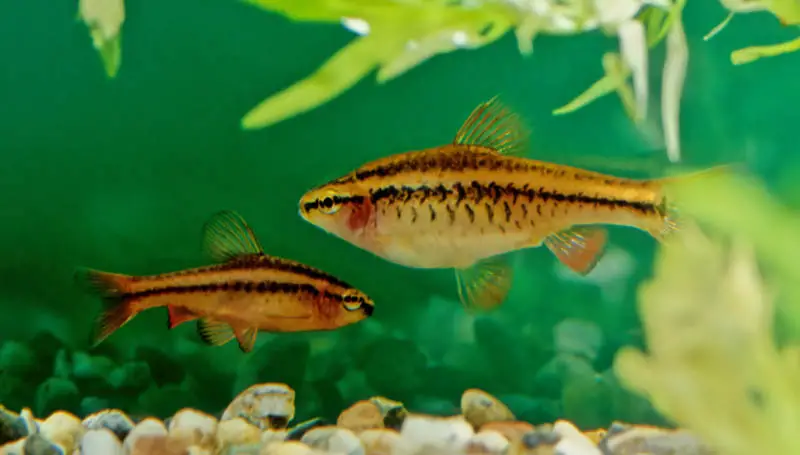The cherry barb is one of those special fish: a beginner mainstay, at the same time as being an expert’s favorite. And, heck, even intermediate fishkeepers love cherry barbs. It’s easy to understand why when you see the rich cherry color of the male.
The Various Names The Cherry Barb Goes By
This fish’s scientific name is puntius titteya. While, in the past it has gone by a couple of other scientific names: barbus titteya and capoeta titteya. And of course the most widely used common name is “cherry barb”. But, it also has another common name I’m quite fond of—“crimson carplet”. Isn’t that a quaint name? It’s got alliteration, but it also illuminates the fish’s resemblance to a tiny little common or koi carp in body shape (even with the barbels).
Appearance Of The Cherry Barb
And it really does have that desirable body shape of a champion koi, just shrank down to a matter of centimeters. And it’s that small size, combined with its bright colors, that make the cherry barb an ideal aquarium fish candidate. A slick looking stripe runs from the cherry barb’s mouth, through its eye, along its flank and ends in thick blot at the base of the caudal fin—as though an artist left their brush on the canvas a moment too long.
Size – How Big Does The Cherry Barb Get?
As we’ve discussed, to its credit as a pet fish, the cherry barb is small. You can expect your cherry barbs to peak at around 2 inches in size, or 5 centimeters.
Sexual Dimorphism – Are The Females And Males Of The Cherry Barb Different?
We don’t usually think of cyprinids (the minnow/carp family) when we think of examples of strong sexual dimorphism. But, the cherry barb is one of a handful of barbs where the difference between the sexes is immediately obvious.
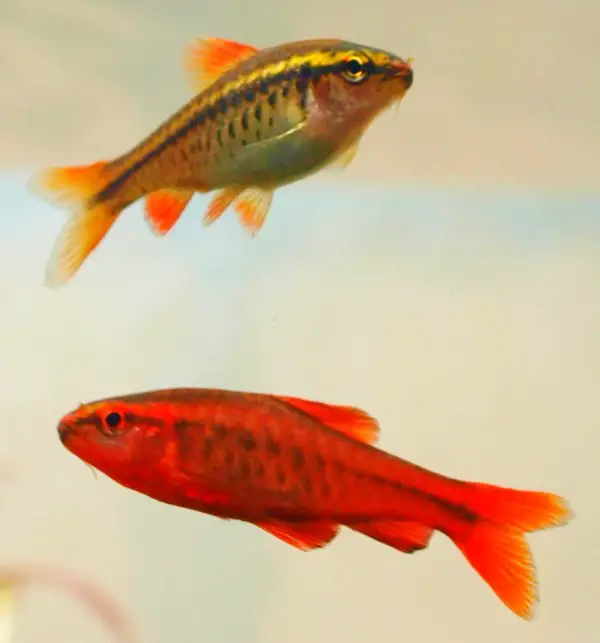
https://commons.wikimedia.org/w/index.php?curid=7631136
Sexual dimorphism is strong in cherry barbs, which is quite unusual for cyprinids.
The male cherry barb displays the cherry red from which this barb gets its name. While, typically, hobbyists refer to the female as more “drab”. But, in my opinion, the females have an appealing aesthetic. The reason for this is that the female has a more intricate pattern: in addition to the main dark stripe, females also have a light stripe above the main dark stripe, and then a second, less opaque, dark stripe.
Diet – What Should I Feed The Cherry Barb?
In the wild, cherry barbs are the quintessential omnivore, i.e. they browse on a little bit of everything. So, we can consider their natural diet to be comprised of things like tiny invertebrates and the larvae of larger invertebrates, as well as all manner of detritus, and algae.
While, in captivity, we can achieve adequate nutrition via a high quality commercial food. For example, a product I recommend, and one that’s growing in popularity in the hobby, is Tetra Color Granules.

Also, a great choice for any small, community fish are the Sera O-Nip tabs. I especially like this food for barbs because it will bring your whole school of barbs together to nibble at the tablet. In case you’re unaware, Sera O-Nip tabs are a small tablet food that you stick to the inside glass of your aquarium.
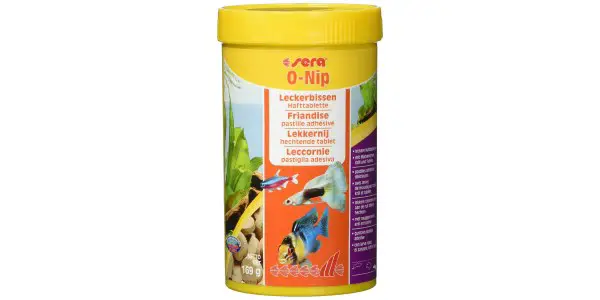
In addition to those dry foods, consider providing frozen foods, and—if at all possible—safe sources of live food.
Also, if your aquarium doesn’t have enough algae for your cherry barbs to graze on, you could consider providing blanched greens such as spinach.
Lifespan – How Long Will The Cherry Barb Live?
For small fish, cherry barbs actually have a fairly long lifespan—you can expect them to live between 5 and 7 years. Feed your cherry barbs a quality diet and keep your water quality high and you’ll be able to maximize their lifespan.
Water Temperature – Does The Cherry Barb Need A Heater?
It really depends. Because, if your room’s ambient temperature is consistently high enough, then there’s really no need for an aquarium heater. So, if you keep your house above 72°F (~22°C), then you don’t really need a heater for your cherry barbs.
However, it’s worth considering using one just in case. For example, I’ve forgotten to set the thermostat when I didn’t know we were in for a cold night—those kind of things happen. Therefore, I like to use heaters even though 99 times out of 100 the temperature is just fine without them.
A recommended temperature range for the cherry barb is 70°F (21°C)to 82°F (27°C).

If you do opt to go with a heater, I really like the Eheim Jager’s—for me, they’re the best heaters I’ve used.
Water pH / Hardness – Does It Matter To The Cherry Barb?
No, not really.
But, let me clarify: if you have wild caught fish, then it will be an issue. While, for farm raised fish, it won’t. The reason for this is that domesticated fish are much more tolerant of a wider range of pH and hardness values. Whereas, wild fish struggle to adapt to water chemistry that differs from their collection point.
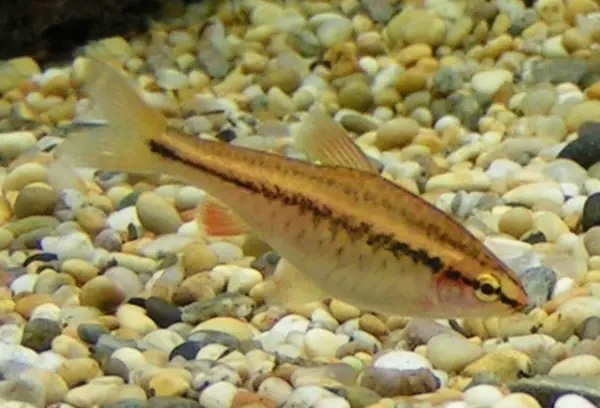
Female cherry barb showing strong horizontal bars.
Next, you might be wondering: how do I tell if fish are wild caught or farm raised? Well, to be direct, your cherry barbs are almost certainly going to be farm raised rather than wild caught. Especially considering the fact that it is now illegal to catch them from the wild.
Temperament – Does The Cherry Barb Nip Or Fight?
No, not really. Barbs in general are known as fin nippers. But, cherry barbs are much less inclined to do this compared to their relatives the tiger barbs.
However, there are some things you need to be aware of in regards to their temperament.

https://commons.wikimedia.org/w/index.php?curid=12683082
Cherry barbs aren’t nippy, so you could–with care–consider them as a potential tank mate for a male betta. Check out this article about keeping bettas and angelfish together.
First of all, they are a schooling fish, so it’s best to keep them in groups of six or more. If you keep a smaller number than this, while it’s unlikely, it could result in some mild aggression.
In addition to keeping them in a group, you’ll also need to be aware of the male to female ratio. This is because males might harass females if they come into breeding condition. It’s not too big of an issue if you have more males than females, as the males aren’t really dangerously aggressive breeders in my experience. But, in an ideal world you’d have an even mix; so, aim for that if you can!
Tank Size – How Big Should My Tank Be For The Cherry Barb?
Tank size is always a contentious issue, and I’ll get into why in a moment.
But, for the time being let’s talk about practical and straightforward advice. Fishlore recommends 20 gallons for a group of five, and I think that’s solid advice.
And while it’s easy to simplify things and say you need an X size tank for Y fish, but the truth is always much more complicated. And while it’s more complicated, it’s also not really something you need to worry about too much. If you find yourself with an overstocked tank, you can perform more and larger water changes to ensure you maintain water quality.
How Will The Cherry Barb Act In My Tank?
Cherry barbs might be a bit timid at first, even being a little shy when it comes to eating. But, after a few days in the tank they will relax and start eating normally.
Once your cherry barbs settle in, they’ll happily occupy the mid-water area of your tank. They’re a schooler, so they’ll stick each other in the tank. And, in my experience, they like to make short darts back and forward as they explore their environment.
How Should I Decorate My Tank To Make The Cherry Barb Happy?
Cherry barbs aren’t too picky when it comes to how their tank should be decorated. But, as I mentioned above, they are very peaceful and a touch timid at times. So, to help minimize any nervousness in your fish, you should consider providing cover in your tank.
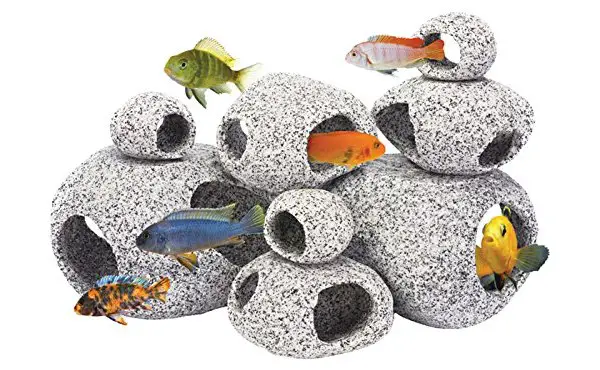
This could be in the form of plants, rocks, caves, or just about any aquarium decoration that can give your cherry barbs a hiding spot to retreat to whenever they feel threatened.
Some Good Examples Of Tank Mates For The Cherry Barb
Well, this could be a long list… because cherry barbs really are one of the virtually perfect community aquarium fish. They can mix with anything around the same size as them, and anything that won’t bully them.
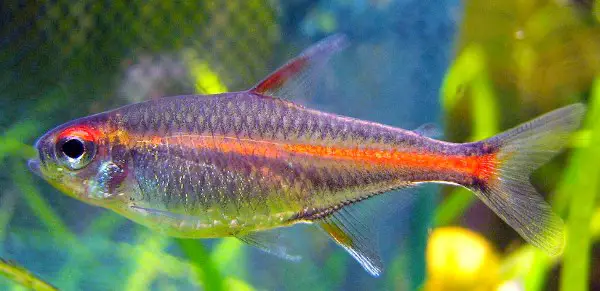
A school of glowlight tetras would be just fine with cherry barbs!
They’ll coexist peacefully with other barbs, tetras, livebearers, corydoras, gourami, and even smaller, more peaceful cichlids! And, unlike other barbs, cherries aren’t nippy, so you can also keep them with long finned varieties of fish. I’d consider a school of cherry barbs as good tank mates for a male betta.
Some Bad Examples Of Tank Mates For The Cherry Barb
Cherry barbs are small. And that’s really all you should be thinking about when you consider their tank mates. Any fish big enough to fit cherry barbs in its mouth should be avoided completely.

Don’t keep your cherry barbs with an oscar, they’ll get eaten!
Reproduction – How To Breed The Cherry Barb
Cherry barbs are nice and easy to spawn. But, before you get into breeding them, make sure you have infusoria ready for the fry, along with a place to keep them when they get bigger.
The first step to breeding your cherry barbs is conditioning them. First and foremost, to condition your cherry barbs, you should feed them a diet of live and frozen foods. A good option is live brine shrimp and frozen bloodworm.
In addition to a good diet, your cherry barbs will need lots of clean and fresh water to trigger them to spawn. So, I recommend doing 50% water changes daily.
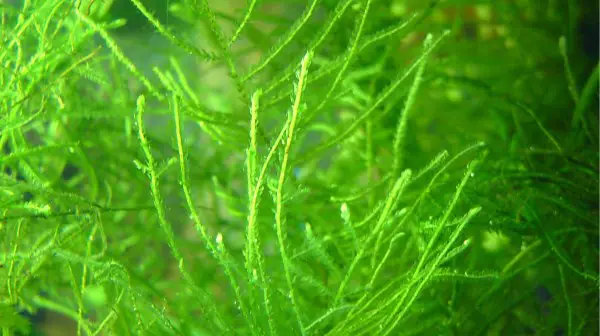
Java moss is a great media for any egg scatterers to spawn on.
You should notice both your males and females brightening in color. Additionally, you’ll see that your females becoming plump with eggs.
Once your group of cherry barbs have been conditioned, it’s time to pick out which fish you want to breed. To do this, select two of the plumpest females, and two of the brightest red males. These four fish will be your breeding group.
Cherry barbs are egg scatterers. So, you’ll need something for the fish to spawn onto. I like to use java moss for this, but you could also use artificial spawning mops or other plants that have dense growth.

Brine shrimp are an excellent live food for your fish.
To trigger the spawn, keep up with the water changes and wait for the magic to happen. You’ll usually wake up in the morning to see that your females have slimmed down dramatically, this is a signal that they have spawned during the night or early in the morning.
Next, you’ll need to switch your attention from the parents to the eggs. After a couple of days, the eggs will hatch. At this point feed infusoria, and then move on baby brine shrimp once the fry are big enough.
In The Wild – Where Does The Cherry Barb Come From?
Cherry barbs are from Sri Lanka, which is an island nation off the south east coast of India.
Sri Lanka has a tropical climate. As such, they experience little variance in climate throughout the year. The temperature generally stays between 77°F (25°C) and 80°F (27°C).
The jungle streams in which the cherry barb can be found are generally clear, but at times do have some mild staining from tannins. Generally, few aquatic plants are present in the water. Although, there is typically dense growth of marginal plants. Streambeds are mostly sand-covered, over which there is a layer of leaf litter and other detritus.
In The Wild – Is This Fish Endangered?
Sadly, yes. During British colonial rule, much of the cherry barb’s habitat was cleared for plantations.

